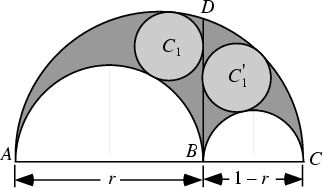Arbelos

The term ``arbelos'' means Shoemaker's Knife in Greek, and this term is applied to the shaded Area in the abovefigure which resembles the blade of a knife used by ancient cobblers (Gardner 1979). Archimedes ![]() himself is believedto have been the first mathematician to study the mathematical properties of this figure. The position of the central notch isarbitrary and can be located anywhere along the Diameter.
himself is believedto have been the first mathematician to study the mathematical properties of this figure. The position of the central notch isarbitrary and can be located anywhere along the Diameter.
The arbelos satisfies a number of unexpected identities (Gardner 1979).
- 1. Call the radii of the left and right Semicircles
 and
and  , respectively, with
, respectively, with  . Thenthe arc length along the bottom of the arbelos is
. Thenthe arc length along the bottom of the arbelos is
so the arc lengths along the top and bottom of the arbelos are the same.

- 2. Draw the Perpendicular
 from the tangent of the two Semicircles to the edge of thelarge Circle. Then the Area of the arbelos is the same as the Area of the Circle withDiameter
from the tangent of the two Semicircles to the edge of thelarge Circle. Then the Area of the arbelos is the same as the Area of the Circle withDiameter  .
. - 3. The Circles
 and
and  inscribed on each half of
inscribed on each half of  on the arbelos (called Archimedes'Circles) each have Diameter
on the arbelos (called Archimedes'Circles) each have Diameter  . Furthermore, the smallest Circumcircle of these two circles has anarea equal to that of the arbelos.
. Furthermore, the smallest Circumcircle of these two circles has anarea equal to that of the arbelos. - 4. The line tangent to the semicircles
 and
and  contains the point
contains the point  and
and  which lie on the lines
which lie on the lines  and
and , respectively. Furthermore,
, respectively. Furthermore,  and
and  bisect each other, and the points
bisect each other, and the points  ,
,  ,
,  , and
, and  are Concyclic.
are Concyclic.

- 5. In addition to the Archimedes' Circles
 and
and  in the arbelos figure, there is a third circle
in the arbelos figure, there is a third circle  called the Bankoff Circle which is congruent to these two.
called the Bankoff Circle which is congruent to these two.

- 6. Construct a chain of Tangent Circles starting with the Circle Tangent to thetwo small ones and large one. The centers of the Circles lie on an Ellipse, and theDiameter of the
 th Circle
th Circle  is (
is ( )th Perpendicular distance to the base of thePappus,
)th Perpendicular distance to the base of thePappus,  whoreferred to it as an ancient theorem (Hood 1961, Cadwell 1966, Gardner 1979, Bankoff 1981). If
whoreferred to it as an ancient theorem (Hood 1961, Cadwell 1966, Gardner 1979, Bankoff 1981). If  , then the radiusof the
, then the radiusof the  th circle in the Pappus Chain is
th circle in the Pappus Chain is
This general result simplifies to for
for  (Gardner 1979). Further special cases when
(Gardner 1979). Further special cases when  are considered by Gaba (1940).
are considered by Gaba (1940). - 7. If
 divides
divides  in the Golden Ratio
in the Golden Ratio  , then the circles in the chain satisfy a number of otherspecial properties (Bankoff 1955).
, then the circles in the chain satisfy a number of otherspecial properties (Bankoff 1955).

References
Bankoff, L. ``The Fibonacci Arbelos.'' Scripta Math. 20, 218, 1954. Bankoff, L. ``The Golden Arbelos.'' Scripta Math. 21, 70-76, 1955. Bankoff, L. ``Are the Twin Circles of Archimedes Really Twins?'' Math. Mag. 47, 214-218, 1974. Bankoff, L. ``How Did Pappus Do It?'' In The Mathematical Gardner (Ed. D. Klarner). Boston, MA: Prindle, Weber, and Schmidt, pp. 112-118, 1981. Bankoff, L. ``The Marvelous Arbelos.'' In The Lighter Side of Mathematics (Ed. R. K. Guy and R. E. Woodrow). Washington, DC: Math. Assoc. Amer., 1994. Cadwell, J. H. Topics in Recreational Mathematics. Cambridge, England: Cambridge University Press, 1966. Gaba, M. G. ``On a Generalization of the Arbelos.'' Amer. Math. Monthly 47, 19-24, 1940. Gardner, M. ``Mathematical Games: The Diverse Pleasures of Circles that Are Tangent to One Another.'' Sci. Amer. 240, 18-28, Jan. 1979. Heath, T. L. The Works of Archimedes with the Method of Archimedes. New York: Dover, 1953. Hood, R. T. ``A Chain of Circles.'' Math. Teacher 54, 134-137, 1961. Johnson, R. A. Modern Geometry: An Elementary Treatise on the Geometry of the Triangle and the Circle. Boston, MA: Houghton Mifflin, pp. 116-117, 1929. Ogilvy, C. S. Excursions in Geometry. New York: Dover, pp. 54-55, 1990.
- Gamma Statistic
- Garage Door
- Garman-Kohlhagen Formula
- Gate Function
- Gauche Conic
- Gaullist Cross
- Gauss-Bodenmiller Theorem
- Gauss-Bolyai-Lobachevsky Space
- Gauss-Bonnet Formula
- Gauss-Bonnet Theorem
- Gauss Equations
- Gaussian Approximation Algorithm
- Gaussian Bivariate Distribution
- Gaussian Brackets
- Gaussian Coefficient
- Gaussian Coordinate System
- Gaussian Curvature
- Gaussian Differential Equation
- Gaussian Distribution
- Gaussian Distribution Linear Combination of Variates
- Gaussian Elimination
- Gaussian Function
- Gaussian Hypergeometric Series
- Gaussian Integer
- Gaussian Integral